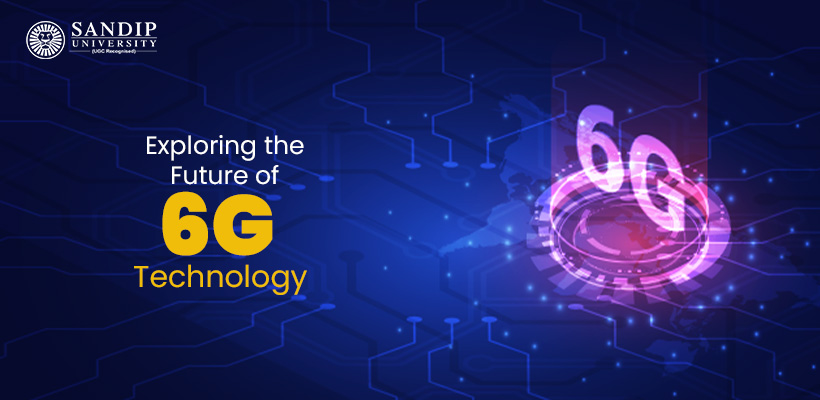As we continue to rely on technology for communication, entertainment, and productivity, the demand for faster, more reliable wireless networks are constantly growing. While 5G technology has just started to make its mark, researchers and experts are already looking ahead to the next big leap in wireless connectivity: 6G technology.
Some of the top engineering colleges in Maharashtra are training students to become skilled telecommunications engineers and create advanced technologies like 6G in the future. In this blog post, we’ll dive into the exciting world of 6G technology, exploring what it is, what it promises, and how it might revolutionise our connected world.
What is 6G Technology?
1. Defining 6G: 6G, or sixth-generation wireless technology, is the next step in the evolution of mobile and wireless communications. It’s expected to succeed 5G, offering even faster data speeds, lower latency, and a more connected world.
2. Timeline: While 5G is still being rolled out globally, 6G is in the early stages of research and development. Commercial deployment of 6G is projected to begin around 2030.
Key Features and Advancements
1. Mind-Blowing Speed: One of the most anticipated features of 6G is its lightning-fast speeds. It is expected to reach terabit per second (Tbps) data rates, making it a hundred times faster than 5G.
2. Ultra-Low Latency: 6G promises to bring ultra-low latency, reducing delays to just a few milliseconds. This is crucial for applications like remote surgery, augmented reality (AR), and autonomous vehicles.
3. Extreme Reliability: 6G networks will offer unparalleled reliability, ensuring that mission-critical applications run smoothly without interruptions.
4. Energy Efficiency: Unlike its predecessors, 6G technology is expected to be highly energy-efficient, reducing the environmental impact of wireless communication.
5. AI Integration: Artificial intelligence (AI) will play a pivotal role in 6G networks, optimising performance, and enabling advanced applications like intelligent transportation systems and smart cities.
Potential Applications
1. Immersive Experiences: 6G will enable truly immersive virtual reality (VR) and AR experiences, transforming how we entertain ourselves and interact with the digital world.
2. Smart Cities: With its ultra-reliable and low-latency connectivity, 6G will be the backbone of smart cities, facilitating real-time monitoring and management of infrastructure, traffic, and public services.
3. Healthcare: Remote surgery and telemedicine will reach new heights with 6G, as doctors can perform surgeries and consult with patients from anywhere in the world.
4. Autonomous Everything: From self-driving cars to drones, 6G will provide the connectivity necessary for autonomous systems to operate safely and efficiently.
Challenges and Concerns:
1. Infrastructure: The deployment of 6G will require significant infrastructure upgrades, including the installation of a vast number of small cells and satellite networks.
2. Security: As with any new technology, security concerns will be paramount. Researchers will need to develop robust security measures to protect against cyber threats.
3. Regulatory and Ethical Issues: The global nature of 6G technology will necessitate international agreements and regulations to ensure fair access and use.
Every country is now setting the objective of collaborating on new features with research in 6G technology. As 6G research begins and technologies are verified for the new applications that 6G will enable, these cutting-edge technologies will be the focus of research, prototyping, and testing in order to achieve the 6G vision.
Various issues must be addressed in the development of 6G technology. This can be used to address the following issues:
A. Spectrum Technology
In high-band 5G, frequencies of 24–47 GHz are used near the bottom of the millimeter wave band. Although higher frequencies may be used in the future. It often achieves download speeds in the gigabyte-per-second (Gbit/s) range, comparable to coaxial cable Internet service. The required spectrum for 6g will explore sub terahertz (THz) frequencies as well as 7 to 24 GHz. This will improve the efficiency of existing spectrum with advancements in MIMO technology.
B. Artificial Intelligence and Machine Learning
The adaptive changes are necessary from Physical Layer Design to network optimization to serve the applications on AI, ML. The data gathering and transmission required to synthesise information will be provided via 6G radio networks. A systems strategy based on data analytic, AI, and next-generation processing capabilities, such as HPC and quantum computing, is required for the 6G technology business. 6G will result in considerable changes to RAN technology and the core communications network fabric due to the confluence of multiple new technologies. Notably, 6G will priorities artificial intelligence.
C. Virtual Model Design: Digital Twins
The virtual representation of real time happening using various simulation platforms is necessary. This mainly consisted of Physical entities in the real environment, supportive software platforms and the data management, data security to link the both things.
D. Network Architecture Design
6G architecture should support both public and private networks. The decentralisation with virtualization of Radio Access network (RAN) is required. Overcoming network problems, enhancing network architecture, and optimising networks are all required in 6G. Furthermore, advanced AI algorithms and robust edge computing will take advantage of 6G’s lightning-fast bandwidth to coordinate complicated networks and provide a continuous Internet connection.
Conclusion
6G technology represents an exciting future for wireless connectivity. With its unparalleled speed, ultra-low latency, and potential to transform industries, it has the potential to reshape the way we live, work, and communicate. While there are still many challenges to overcome, the promise of 6G is enough to make tech enthusiasts eagerly anticipate the next generation of wireless technology.
Some of the best electronics and telecommunication colleges in Maharashtra are including 6G into their curriculum to help students understand the technology in-depth. Stay tuned for more updates on the development and deployment of 6G as we move closer to the era of sixth-generation connectivity.

